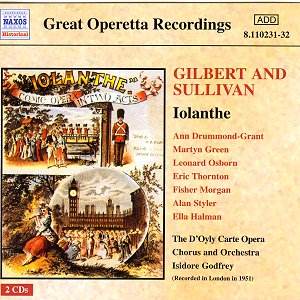This
set is taken from 78 record matrices and was released in the form
of Decca LPs in their LK label series. The recording is taken
from amongst the last conventionally cut 78-rpm wax masters made
in the UK. There are two other CD releases of this recording by
Regis and Sounds on CD (without the Pineapple Poll coupling)
and all are well engineered.
Arthur
Sullivan was Britain’s most important composer of the Victorian
age, having written a symphony, oratorios, songs, hymns and theatre
music. He received a classical musical training, first as a chorister
and later as a student at the Royal Academy of Music, London.
A Mendelssohn scholarship took him to Leipzig where he was immersed
in the music of the German romantics. As a composer he was skilled
in providing catchy melodies and songs with good orchestration:
he even inaugurated a unique genre of English operetta.
With
witty lyrics by W.S. Gilbert, the Gilbert & Sullivan comic
operas have stood the test of time and are as popular today as
they were 100 years ago. The partnership between Gilbert and Sullivan
was initiated by the enterprising theatre manager, Richard D'Oyly
Carte. Carte brought them together to write fourteen comic operas,
the seventh of which was Iolanthe.
This
recording was released in the Festival of Britain year (1951)
and much effort was made to ensure that the quality of production
was fitting for the time. As with previous recordings, the orchestra
is an augmented theatre orchestra and although the playing is
excellent in every way the strings lack that fullness we expect
nowadays. Under the direction of D'Oyly Carte's Isidore Godfrey
we are given a lively reading of the score and more sensitivity
expressed than is sometimes found in the Sargent EMI recordings.
Of
the cast, Martyn Green, Ella Halman, Ann Drummond-Grant and Leonard
Osborn were long-serving Savoyards who played these roles on stage
both pre-war and post-war. Margaret Mitchell, Alan Styler and
Fisher Morgan joined in the 1940s. Thus we have an experienced
stage-performing cast brought into the studio for this recording;
all names remembered with affection. We occasionally hear how
Martyn Green was better than Peter Pratt or John Reed in the part,
but all three had their qualities, bringing different interpretations
to the role of Lord Chancellor. Green had replaced Henry Lytton
who in the last decade of his career was a poor singer. In the
earlier 78s HMV-Sargent electric recordings (c.1930) Lytton's
parts were played by George Baker who had never appeared on stage
yet offered excellent diction and clarity of voice. It is probably
the contrast with Lytton that has caused Green to be remembered
so warmly. Like Baker, his musicality and diction are good. Margaret
Mitchell as a pert, warm-toned soprano conveys the innocence of
Phyllis convincingly. Ann Drummond-Grant, wife of Godfrey, was
one of the longest serving members of the company by the time
of this recording. Starting out as a soprano her pleasant characteristic
voice thickened to a mezzo in the 1940s, and in the late 1950s
before an ‘early death’ to a contralto. Her velvety timbre and
attention to dynamics as captured here are again enjoyed. Leonard
Osborn is a tenor who disappoints or perhaps one who will be appreciated.
A harsh vibrato marred some of his 1930s recordings but this had
tended to soften by the time of this recording. Yet he still annoys
when he glides to a high note and still holds a vibrato. This
provides an odd braying effect that hits a raw nerve. Ella Halman
is a formidable Fairy Queen with wide compass and clear diction.
By
the early 1950s opera recordings enjoyed a wider acoustic than
the characteristic 'box effect' of earlier electric recordings.
Here it is not as spacious as the Waterford and Walthamstow Town
Hall locations and the recording did not enjoy the miking techniques
that were to become a hallmark of the later Decca recordings.
A
wider acoustic is provided for the ballet recording. Here, the
tracks are recognised as taken from LP masters as the surface
noise on tr.15 confirms. This LP transcription is not ideal, there
being a shift of middle registers to the upper end of the spectrum.
This seems to thin the sound quality.
A
word should be said about Pineapple Poll. In late
1950 Sullivan's music had come out of copyright and Charles Mackerras
had the brilliant idea of interweaving some of the best themes
into a ballet based on one of Gilbert's Bab Ballads. There are
two recordings avaiable and both are by Mackerras. The first was
issued on the Pye LP label (1951). What is generally not pointed
out is that the later one, recorded in 1982 [and currently coupled
with Princess Ida on Decca 436 810-2] contains subtle differences
in orchestration from the earlier recording, mainly phrases of
decoration in the brass and woodwind sections that, in my opinion,
is in places overdone. Consequently, this recording provides an
enjoyable listening experience.
A
note about the transcription: it seems to be taken from 78 matrices
rather than early tape masters.
Decca
was slow in converting to tape principally because of fickle reliability
of the medium at the time of its introduction. Pianissimo passages
contain a distant (muted) roar on some of the matrices. This is
a problem that no modern sound engineer can overcome. In the Pineapple
Poll suite some electronic sharpening has been provided to lift
the treble frequencies. It tends to give the strings a brittle
edge in the high registers, but is not overdone and certainly
helps widen the frequency response.
Further
information: Bk. Gilbert & Sullivan, Ainger (Routledge 2003)
with review at: http://www.musicweb-international.com/classrev/2003/Mar03/ainger.htm
Other
CDs of this 1951 Iolanthe recording:
Pearl
(coupled with Patience): GEMS0163
Regis
(coupled with Pineapple Poll): RRC2049
Sounds
on CD: VGS 219
Raymond
Walker
